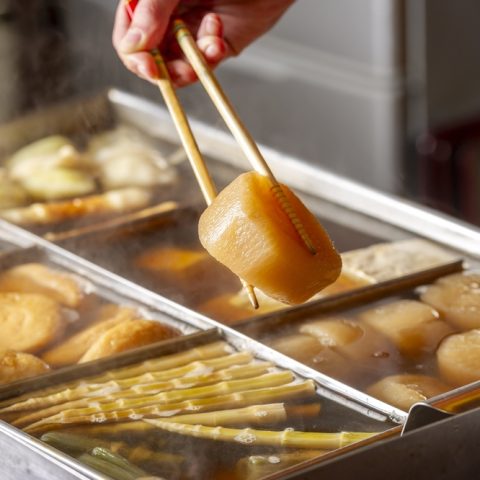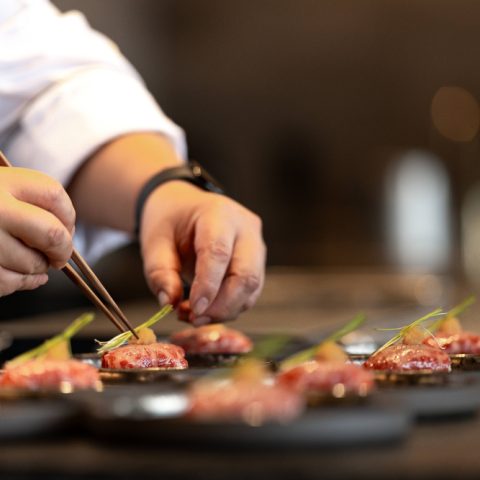
Wagyu (和牛) is a breed of cattle originating from Japan, known for its marbling and high-quality meat. The word “Wagyu” can be roughly translated to mean “Japanese cattle” (wa = Japanese, gyu = cattle). These cattle are renowned for their unique genetics, which result in meat that is incredibly tender, richly flavored, and highly sought after by chefs and consumers worldwide. Come join us as we take you through a short introduction to everything you need to know in the world of Wagyu.

Bisho Beef by moreau tokyo on Unsplash
Marbling
One of the most distinguishing features of Wagyu beef is its high degree of intramuscular fat, commonly referred to as marbling. This marbling is distributed evenly throughout the meat and gives it a buttery texture and a rich, savory flavor. This particular feature of Wagyu is often rated on a scale, with higher marbling grades indicating a greater degree of fat.
Wagyu Breeds
There are several Wagyu breeds, the most famous being the Japanese Black (Kuroge Washu), Japanese Brown (Akage Washu), Japanese Shorthorn (Nihon Tankaku Washu), Japanese Polled (Mukaku Washu), and Japanese Shorthorn (Nihon Tankaku Washu). Among these, Japanese Black Wagyu is the most common and prized for its marbling.

“Sukiyaki Kobe Beef” by Matsubokkuri on wikimedia commons
Regional Variations
Different regions in Japan have their own unique Wagyu, each with distinct characteristics. For example, Kobe beef is a type of Wagyu that comes from the Hyogo Prefecture and is known for its exceptional quality. Other regional Wagyu varieties include Matsusaka beef, Omi beef, and more.
Grading System
The Wagyu grading system in Japan is a highly detailed and precise system used to evaluate the quality of Wagyu beef based on various factors, including marbling, meat color, texture, and fat quality. This grading system helps consumers and producers understand the quality and characteristics of the meat. The highest-quality Wagyu beef is given the top grades, with the most coveted being the prestigious A5. Here’s an overview of the Wagyu grading system:
- Yield Grade (A, B, or C):
The yield grade assesses the quantity of usable meat obtained from a carcass. It is determined by evaluating the meat-to-bone ratio and fat distribution.
Grade A: The highest yield grade, indicating a higher meat-to-bone ratio and less excess fat.
Grade B: Intermediate yield grade.
Grade C: The lowest yield grade, indicating a lower meat-to-bone ratio and more excess fat. - Quality Grade (1 to 5):
The quality grade assesses the overall quality of the meat, including factors like marbling, meat color, texture, and fat quality.
Grade 1: Lowest quality grade.
Grade 5: Highest quality grade.
- Marbling Score (1 to 12):
Marbling is one of the most critical factors in determining the quality of Wagyu beef. The marbling score evaluates the amount and distribution of intramuscular fat within the meat.
Score 1: Minimal marbling.
Score 12: Abundant and evenly distributed marbling. - Beef Color (from Brightness 1 to 7):
This assesses the color of the meat, with lower numbers indicating a brighter color and higher numbers indicating a darker color. Brightness 1 is the most desirable. - Texture and Fat Quality (from Firmness 1 to 5):
This evaluates the texture of the meat and the quality of the fat. Higher numbers indicate better texture and fat quality.
The final grade for Wagyu beef is typically expressed in a format like “A5,” with “A” representing the yield grade and “5” representing the combined score of the other measurements. An A5 grade is the highest possible rating and indicates the best-quality Wagyu beef available. It’s important to note that the grading system is used primarily in Japan, and authentic Japanese Wagyu is graded accordingly. Outside of Japan, different grading systems may be used, and they may not always align with the Japanese system.

“Wagyu Yakiniku Rolls” by Alpha via Wikimedia Commons
And there you have it, a crash course on Wagyu with information that you can show off at your next gathering! In recent years, the popularity of Wagyu beef has grown significantly, making it easier to find in Japan in various ways, such as the indulgent Matsusaka burgers in Tokyo or the more traditional Hitachi wagyu beef in Ibaraki. Additionally, here are some restaurants we recommend visiting to get your fix of wagyu.
- Matsukiya
Matsukiya specializes in Omi beef, a type of wagyu originating in the Shiga Prefecture. Their restaurant specifically, serves omi beef dry aged at low temperatures, which reportedly draws out its umami and is served in a variety of ways. - Shu Ginza Teppanyaki & Steak
Highly recommended from our team at Arigato Travel, Shu Ginza is an amazing restaurant serving wagyu and other delicious delicacies, making up a memorable culinary experience. The chefs are extremely skilled and meticulous in their craft and ensure that every bite you take exceeds your expectations. - Wagyu to Worldwide
With an intriguing name like Wagyu to Worldwide, it would be difficult to guess that this restaurant specializes in the previously mentioned Wagyu burgers! This restaurant offers an affordable and accessible way to indulge in Matsusaka beef, one of the other three most famous Wagyu brands in Japan.
Don’t plan on visiting Japan but still want to try Wagyu? No need to worry! While Wagyu cattle are originally from Japan, they have been exported to various countries around the world, meaning that you can now find Wagyu beef in many countries, including the United States, Australia, and the United Kingdom.
Featured image by Nishimuraya Kinosaki Onsen on wikimedia common
Book a slot on our TOP 5 Japanese Foods online experience to discover more delicious dishes to try during your trip!





